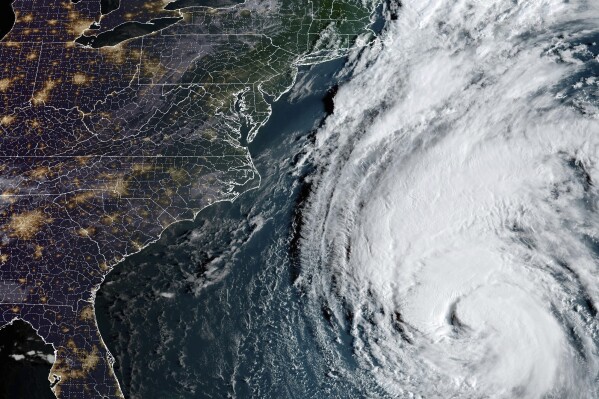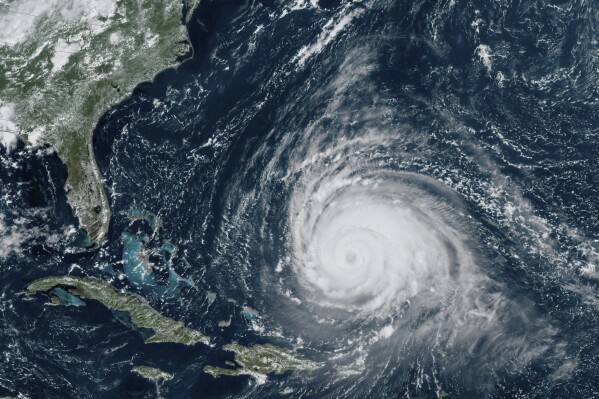Hurricane Lee to strike weather-worn New England after heavy rain, flooding and tornadoes
PORTLAND, Maine (AP) — After a deluge of rain, flooding, sinkholes and tornadoes this week, New England is about to face Hurricane Lee.
As the Category 1 system impacted Bermuda, Maine was under its first hurricane watch in 15 years and a state of emergency declared Thursday by Gov. Janet Mills. The water-logged region prepared for 20-foot (6-meter) waves offshore and wind gusts up to 80 mph (129 kph), along with more rain.
The hurricane watch applied to eastern Maine, while the rest of the state and an area extending south through Massachusetts was under a tropical storm warning. Powerful winds and coastal flooding were expected to arrive Friday afternoon in southern New England and spread north.
Although Lee did not contribute to the flooding that hit New England earlier in the week, it threatened to exacerbate conditions in a region that is already waterlogged.
 How hard will Hurricane Lee hit New England? The cold North Atlantic may decide that
How hard will Hurricane Lee hit New England? The cold North Atlantic may decide that
 After days of heavy rain, flooding and tornadoes in New England, Hurricane Lee up next
After days of heavy rain, flooding and tornadoes in New England, Hurricane Lee up next
 Heavy surf is pounding Bermuda as Hurricane Lee aims for New England and Atlantic Canada
Heavy surf is pounding Bermuda as Hurricane Lee aims for New England and Atlantic Canada
The Coast Guard and emergency management agencies warned New England residents to be prepared, and utility companies brought in reinforcements to deal with any power outages. At Boothbay Harbor Marina in Maine, the community came together to remove boats from the water to keep them out of harm’s way.
“It’s a batten-down-the-hatches kind of day,” owner Kim Gillies said Thursday.
Similar scenes played out elsewhere, including at Kennebunkport Marina, where crews planned to take 100 boats out of the water, said Cathy Norton, marina manager.
Commercial lobster fisherman Steve Train said fishermen have been sinking gear in deeper water to protect against storm damage. Fishing boats were also headed to the safety of harbors.
In Canada, residents of western Nova Scotia and southern New Brunswick were warned about the risk of power outages and flooding this weekend. A year ago, the remnants of Hurricane Fiona washed houses into the ocean, knocked out power to most of two provinces and swept a woman into the sea.
New Brunswick Minister of Public Safety Kris Austin urged residents to assemble a 72-hour safety kit that included batteries, water, food, medication and a radio.
In her emergency declaration, the Maine governor urged people to take the storm seriously and to make preparations. Mills, a Democrat, also asked President Joe Biden to issue a preemptive presidential disaster declaration to give the state access to federal resources.
Earlier in the week, the region saw 10 inches (25 centimeters) of rain over six hours. Tornado warnings were issued Wednesday in Massachusetts and Rhode Island, and more heavy rain created sinkholes and brought devastating flooding to several areas.
The National Weather Service in Boston confirmed Thursday that damage to trees and power lines in Massachusetts, Rhode Island and Connecticut the day before was caused by four tornadoes.
Dozens of trees snapped or were uprooted by a twister in the town of Glocester, Rhode Island, and a structure used as a bus shelter was blown away, the weather service said. The three tornadoes in Connecticut and Rhode Island were categorized as EF-1, while the one in North Attleboro, Massachusetts, was an EF-0.
Thursday night, Lee was spinning 185 miles (300 kilometers) west of Bermuda, with maximum sustained winds of 85 mph (140 kph), according to the National Hurricane Center. It was traveling north on a path that could lead to landfall in Nova Scotia, possibly as a tropical storm, forecasters said.
The system could bring a mix of threats. The storm surge and waves could lash the coast, damaging structures and causing erosion; powerful wind gusts could knock down trees weakened by a wet summer; and rain could cause flash flooding in a region where the soil is already saturated, said Louise Fode, a National Weather Service meteorologist in Maine.
The state’s eastern coast — known as the Down East region — and the coast of Nova Scotia and New Brunswick were expected to bear the brunt of the storm, though the track could shift before the system arrives, Fode said.
One thing working in the region’s favor: The storm surge will not be accompanied by an astronomical high tide, helping to lower the risk, she said.
New England has experienced its share of flooding this summer, including a storm that dumped up to two months of rain in two days in Vermont in July, resulting in two deaths. Scientists are finding that storms around the world are forming in a warmer atmosphere, making extreme rainfall more frequent.
Massachusetts Gov. Maura Healey issued a state of emergency Tuesday following “catastrophic flash flooding and property damage” in two counties and other communities. The torrential downpour in a six-hour period was a “200-year event,” said Matthew Belk, a meteorologist with the National Weather Service in Boston.
The rain created sinkholes in Leominster, Massachusetts, including one at a car dealership that swallowed several vehicles. In Providence, Rhode Island, firefighters used inflatable boats to rescue more than two dozen people stranded in cars in a flooded parking lot.
In Maine, the last time a hurricane watch was declared was in 2008, for Hurricane Kyle, but residents are accustomed to rough weather. Lee’s projected wind, rain and surf are akin to a powerful Nor’easter, and Mainers are familiar with those.
___
Associated Press journalists Rob Gillies in Toronto and Robert F. Bukaty in York, Maine, contributed to this report.
Disclaimer: The copyright of this article belongs to the original author. Reposting this article is solely for the purpose of information dissemination and does not constitute any investment advice. If there is any infringement, please contact us immediately. We will make corrections or deletions as necessary. Thank you.






